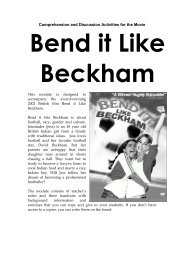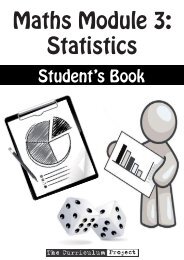Download - The Curriculum Project
Download - The Curriculum Project
Download - The Curriculum Project
Create successful ePaper yourself
Turn your PDF publications into a flip-book with our unique Google optimized e-Paper software.
B. Read through the situations and clarify anything students don’t understand.Brainstorm a list of things you could say in each of these situations.Suggestions:1. (bus) – Yes, it is. I’m tired. Do you travel here often? Where are you going? etc.2. (meeting) – Hello. My name is (Zin Mar) . Have we met before? Were you at(the meeting last week) ?3. (conference) – That was a very interesting speech. Did it take you long to write?I don’t know a lot about (fish farming) , but that was really interesting. etc.4. (teacher) – Sayama Nu? Do you remember me? I’m May May.You taught me in 5 th standard, in 1997. Are you still teaching at No 2 school?4.3 Formal or informal?A. Play audio 12.5. Students listen, and decide which conversation is more formal.Answer: Conversation 1Play audio 12.5 again. Students identify the topics in each conversation.Answers: Conversation 1: Organisation, duties and responsibilities, home townConversation 2: <strong>The</strong> weather, places they’ve been to, favourite food and musicB. Point out that when we want to keep a conversation going, it is important to ask questions. Thisdemonstrates you are interested in the person you are talking to.Play audio 12.5 again. Students identify which questions the speakers use to get more information.Answers:Conversation 1: Are you still with the UNDP? So, how long are you here this time?What’s that like?So, what do you do for the UNDP?Conversation 2: Where are you from? What’s it like?Do you like Chinese food? Have you heard much Chinese music? Is it good?C. Play audio 12.5 again. Students identify what words and noises the speakers make to show they areinterested in the conversations.Answers: Conversation 1: Really? Uh-huh. Oh? Yes? Conversation 2: Yeah. Mmmm.D. Roleplay. In pairs, students choose one of the situations in 4.2 A. <strong>The</strong>y create a conversation. Give them afew minutes to prepare, and get a few pairs to perform their conversations to the class.5. Pronunciation: Expressing InterestThis section focuses on using intonation to demonstrate you are interested in another person, and want to listento what they are saying.5.1 IntonationA. Play audio 12.6. Students decide in which conversation the woman sounds more interested, 1 or 2? Whydo they think this?Answer: 2. Her voice rises and falls more. In 1, she speaks in almost the same tone throughout.Explain to students: Intonation is variation of pitch (‘high’ and ‘low’ sounds) when speaking. Peopleusually talk in a higher pitch, or in a varying pitch (up and down), when they are interested in theconversation. If people talk in a low, flat pitch, it can sound like they are not interested.B. In pairs, students practise introducing themselves and sounding interested in their partner. <strong>The</strong>conversation from A is a useful model conversation – students can find it in the audioscripts.C. Play audio 12.7. <strong>The</strong>se are examples of people sounding interested. Students repeat, focusing onintonation. It will be difficult for students to copy the intonation exactly the same as the audio. That’sOK. <strong>The</strong> main point of this exercise is to expose students to the idea that people vary their speakingtone when they want to sound interested.5.2 Are you interested?A. Students take a few minutes to think of appropriate responses to these remarks.Students work in pairs, taking turn to remark and respond. <strong>The</strong>y should focus on intonation.70 Module 12



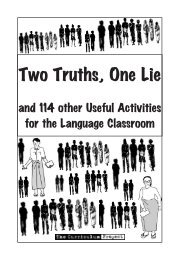


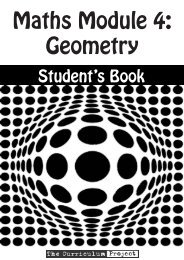


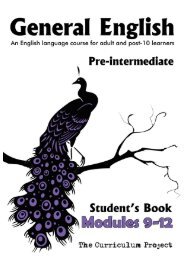


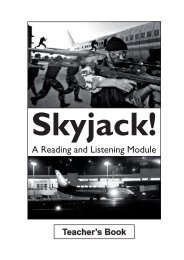
![[Eng] Nov 2012 DRAFT - The Curriculum Project](https://img.yumpu.com/45590859/1/184x260/eng-nov-2012-draft-the-curriculum-project.jpg?quality=85)
